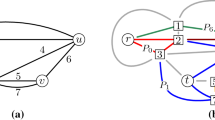Abstract
The defect of a (partial) order relationP is defined to be the rank of the kernel of the associated incidence matrix. Gierz and Poguntke [7] have shown that the defect provides a lower bound for the number of incomparable adjacent pairs in an arbitrary topological sorting ofP. We show that this bound is sharp for interval orders without odd crowns. Furthermore, an efficient algorithm for topological sortings of such orders is presented which achieves the bound. We finally exhibit a natural matroid structure associated with the optimal topological sortings under consideration, which permits to solve the weighted case.
Zusammenfassung
Der Defekt einer HalbordnungP ist definiert als der Korang der zugehörigen Inzidenzmatrix. Gierz und Poguntke [7] haben den Defekt als eine untere Schranke für die Anzahl von Paaren unvergleichbarer Elemente, die in einer gegebenen linearen Erweiterung benachbart auftreten können, nachgewiesen. Wir zeigen, daß für Intervallordnungen ohne ungerade Kronen die Schranke exakt ist, und wir geben einen effizienten Algorithmus zur Konstruktion linearer Erweiterungen an, die in diesem Fall die Schranke erreichen. Wir weisen weiter nach, daß die Menge der optimalen linearen Erweiterungen einer solchen Ordung in natürlicher Weise eine Matroidstruktur induziert, die sich zur Lösung des gewichteten Problems verwenden läßt.
Similar content being viewed by others
Explore related subjects
Discover the latest articles, news and stories from top researchers in related subjects.References
Cogis, O., Habib, M.: Nombre de sauts et graphes séries parallèles. R.A.I.R.O. Inform. Théor.13, 3–18 (1979).
Duffus, D., Rival, I., Winkler, P.: Minimizing setups for cycle-free ordered sets. Proc. Am. Math. Soc.85, 509–513 (1985).
Faigle, U., Gierz, G., Schrader, R.: Algorithmic approaches to setup minimization. SIAM Journ. Computing14, 954–965 (1985).
Faigle, U., Schrader, R.: A setup heuristic for interval orders. Operations Res. Letters4, 185–188 (1985).
Faigle, U., Schrader, R.: Minimizing completion time for a class of scheduling problems. Inform. Proc. Letters19, 27–29 (1984).
Faigle, U., Schrader, R.: Setup minimization techniques for comparability graphs. In: Graphtheoretic Concepts in Computer Science (Noltemeier, H., ed.), pp. 101–117. Linz: Trauner Verlag 1985.
Gierz, G., Poguntke, W.: Minimizing setups for ordered sets: a linear algebraic approach. SIAM Journ. Algebr. Discr. Methods 132–144 (1983).
Golumbic, M. C.: Algorithmic Graph Theory and Perfect Graphs. New York: Academic Press 1980.
Lawler, E. L.: Combinatorial Optimization: Networks and Matroids. New York: Holt, Rinehart and Winston 1976.
Rival, I.: Optimal linear extension by interchanging chains. Proc. Amer. Math. Soc.89, 387–394 (1983).
Author information
Authors and Affiliations
Additional information
Supported by Sonderforschungsbereich 303 (DFG), Institut für Operations Research, Universität Bonn, Federal Republic of Germany.
Rights and permissions
About this article
Cite this article
Faigle, U., Schrader, R. Interval orders without odd crowns are defect optimal. Computing 38, 59–69 (1987). https://doi.org/10.1007/BF02253744
Received:
Revised:
Issue Date:
DOI: https://doi.org/10.1007/BF02253744




